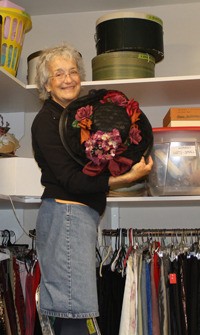For Whidbey Island Center for the Arts’ production of “Into the Woods,” Mira Steinbrecher is the mastermind behind the show’s 40 captivating costumes.
Steinbrecher has been working as a professional costume designer for over 40 years, and knows every trick of the trade, from using strong tea to dull too-bright whites to crafting an apron suitable for hiding both knives and sweet breads. She is also a professional architect who placed among the top 50 architects in Northwest Home and Garden magazine in fall, 2006.
Steinbrecher volunteers her time at Whidbey Island Center for the Arts where, up to and beyond opening night, she works feverishly to ensure that each pin, seam and stitch is perfectly in place; she also assists with hair and makeup. Her architectural eye is abundantly apparent upon viewing her work, and Steinbrecher said she regularly employs her knowledge of engineering and design to the stage.
“Into the Woods” is a Tony award-winning musical based on a book written by James Lapine and adapted for the stage by Stephen Sondheim. The Whidbey Island Center for the Arts production is directed by Robert W. Prosch.
The story, much like Steinbrecher’s creative process, is a blending of several pieces into a cohesive and enticing whole, following the characters from well-known Brothers Grimm fairytales—Jack and the Beanstalk, Cinderella, Little Red Riding Hood and Rapunzel — as they learn the consequences of their wishes and quests. The production is intertwined with another story of a childless baker, his wife and the witch who curses them.
In order to concoct the perfect costume, Steinbrecher said she uses hints gleaned from the script as well as consultations with the director and a well-honed knowledge of period wear. Usually, she said, there is a driving concept which acts as inspiration for the whole.
For a previous production of “Our Town,” a play which takes place in the early 1900s, Steinbrecher explained that she used a vase of dried hydrangeas as her guiding inspiration.
“One of the things I like to do with art is collage. I realized that costumes are really 3-dimensional collages displayed to the public under varying light,” she said.
In “Into the Woods,” she noted that the vignettes featuring respective character groups helped her to guide her artistic concept, which features an array of specific color palettes and shapes associated with each intertwining story.
In part because each of the Brothers Grimm fairy tales has a different origin, there is no set time period in which the overarching story takes place, allowing for some creative license on the part of the crew.
Little Red Riding Hood sports an outfit reminiscent of the Alpines complete with dirndl, apron, mop hat and two capes, while Cinderella and her stepsisters are adorned in voluminous bloomers, cinched corsets and brightly colored fascinators. The baker’s wife’s attire demonstrates Steinbrecher’s keen eye for patterns, shapes and color combinations with its variety of prints which seem to have been melded effortlessly.
Steinbrecher explained that while a person may never think to wear certain attire in real life, these elements and textures are what pop under the bright stage lights.
While she makes many pieces by hand, Steinbrecher also repurposes many items. A duvet cover could become a skirt, a thrifted sheet a cape, or an old dress a new, enticing ensemble.
“Before anything else I’m a problem solver, which makes me a good architect and costumer,” she said, recalling that in high school she considered herself “a seamstress with an engineer’s brain.”
Katie Woodzick, who plays Little Red Riding Hood, has been participating in theater since the age of 7.
“She is by far the most detailed costumer I have ever worked with,” said Woodzick. “She’s very meticulous; every night until opening night she was adding shawls or little embellishments to make everything come together as a story on stage. She’s very dedicated.”
Woodzick explained that for her, costume is an essential element to the character-building process.
“I build a character from a very visual place, so I don’t feel like I have the finished thing until the final tech rehearsal when I finally see myself in the mirror, lose myself and see the character,” she said, adding that playing an iconic character such as Little Red Riding Hood added to the necessity for a perfect costume, which Steinbrecher delivered. “She did a really good job of keeping the iconic elements while putting her own spin on it … I like how I kind of look like a cartoon and it informs the playful nature of the character.”
Hannah McConnaughey, who plays one of Cinderella’s two cruel step sisters, concurred that Steinbrecher’s architectural talents play out notably in her costumes, particularly in the lavish ball gowns and other detailed accoutrements worn by Cinderella and her relatives.
“The way she puts together elements of costumes and the way she combines colors … has an eye to that overall architectural shape,” she said. “She has such a sense of overall perfectionism that I think the costumes are absolutely flawless.”
“She is the costume fairy godmother,” McConnaughey said.



